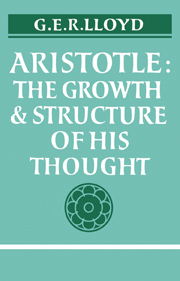Book contents
- Frontmatter
- Contents
- Preface
- Abbreviations
- PART I INTELLECTUAL DEVELOPMENT
- PART II FUNDAMENTALS OF ARISTOTLE'S THOUGHT
- 6 Logic and metaphysics
- 7 The physics of the heavenly region
- 8 The physics of the sublunary region
- 9 Psychology
- 10 Ethics
- 11 Politics
- 12 Literary criticism
- 13 Conclusion
- Suggestions for farther reading
- Glossary of Greek terms
- Index of passages referred to
- General Index
8 - The physics of the sublunary region
Published online by Cambridge University Press: 06 July 2010
- Frontmatter
- Contents
- Preface
- Abbreviations
- PART I INTELLECTUAL DEVELOPMENT
- PART II FUNDAMENTALS OF ARISTOTLE'S THOUGHT
- 6 Logic and metaphysics
- 7 The physics of the heavenly region
- 8 The physics of the sublunary region
- 9 Psychology
- 10 Ethics
- 11 Politics
- 12 Literary criticism
- 13 Conclusion
- Suggestions for farther reading
- Glossary of Greek terms
- Index of passages referred to
- General Index
Summary
The transmission of movement
The ultimate source of movement, in Aristotle's system, is the unmoved mover who acts as a final cause, by being loved. The ‘moved movers’—the heavenly bodies or more properly the spheres that carry them—transmit movement in turn as efficient causes. But whereas throughout the heavenly region movement is eternal and unchanging, in the region below the moon there is both movement and change. Change is brought about primarily because the course of the sun in the ecliptic is oblique to the axis of the earth. This oblique course of the sun causes the changes in the seasons, the ceaseless pendulumlike movement between the two extremes of the heat and dryness of summer and the cold and wet of winter, changes which are, of course, a good deal more striking in the Mediterranean than they are in our own more temperate climate.
In making the sun the source of change in the sublunary region Aristotle was no doubt chiefly influenced by the manifest fact that the generation and decay of many living things, especially plants, are closely linked with the seasons. There are, however, several serious difficulties both in his view of the relation between the heavenly and the sublunary regions, and in his theory of the transmission of movement from one to the other, and these must be considered before we discuss his account of the sublunary region as a whole.
- Type
- Chapter
- Information
- AristotleThe Growth and Structure of his Thought, pp. 159 - 180Publisher: Cambridge University PressPrint publication year: 1968



